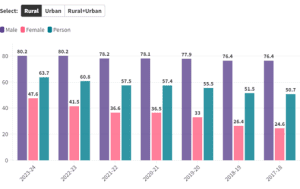TAG: GS-3: ECONOMY
THE CONTEXT: Recently, the Periodic Labour Force Survey (PLFS) released its 7th annual report for July 2023 to June 2024.
EXPLANATION:
What is the Periodic Labour Force Survey (PLFS)
- It is a survey conducted by the NSO under the Ministry of Statistics and Programme Implementation (MoSPI) to measure the employment and unemployment situation in India.
- The NSO launched the PLFS in April 2017.
Key Highlight Employment and Unemployment Indicators
- Labour Force Participation Rate (LFPR) is defined as Percentage of persons in the labour force (i.e. working or seeking or available for work) in the population.
- Worker Population Ratio (WPR): Percentage of employed persons in the population.
- Unemployment Rate (UR): Percentage of persons unemployed among the persons in the labour force.
- Activity Status – Determined on the basis of the activities pursued by the person during the specified reference period.
- Usual Activity Status: Activity Status of a person in the last 365 days which Includes both ps and ss.
- Principal activity status: The activity status on which a person spent relatively long time (major time criterion) for 365 days preceding the date of survey, was considered the usual principal activity status of the person.
- Subsidiary economic activity status (ss): Activity status in which a person in addition to his/her usual principal status, performs some economic activity for 30 days or more for the reference period of 365 days preceding the date of survey.
- Current Weekly Status (CWS): Activity status determined on the basis of a reference period of last 7 days preceding the date of survey.
Key Points for the Labour Force Participation Rate (LFPR):
Overall Increase in LFPR:
-
- Rural Areas: LFPR increased from 50.7% in 2017-18 to 63.7% in 2023-24.
- Urban Areas: LFPR increased from 47.6% to 52.0% during the same period.
Gender-wise LFPR Trends:
-
- Male LFPR: Increased from 75.8% in 2017-18 to 78.8% in 2023-24.
- Female LFPR: Notable increase from 23.3% to 41.7% during this time.
Rural vs Urban Comparison:
-
- Rural areas witnessed a larger jump in LFPR compared to urban areas, showcasing a substantial growth in workforce engagement in rural regions.
Female Participation:
-
- A significant rise in female participation in the workforce (from 23.3% to 41.7%) highlights the growing inclusion of women in economic activities.

Objective of the Periodic Labour Force Survey:
- To estimate the key employment and unemployment indicators (viz. Worker Population Ratio, Labour Force Participation Rate, Unemployment Rate):
- Short-term urban focus: Estimate key employment and unemployment indicators for urban areas every three months using the Current Weekly Status (CWS).
- Annual rural and urban assessment: Estimate employment and unemployment indicators for both rural and urban areas annually, using both the Usual Status and CWS.
Government institute:
- Prime Minister Rozgar Yojana (PMRY)
- Atmanirbhar Bharat Rozgar Yojana (ABRY)
- Pradhan Mantri Rojgar Protsahan Yojana (PMRPY)
- National Career Service (NCS)
- Mahatma Gandhi National Rural Employment Guarantee Act (MGNREGA)
Source:
Spread the Word



